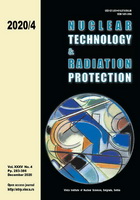
FILAMENT MATERIAL EVALUATION FOR BREAST PHANTOM FABRICATION USING THREE-DIMENSIONAL PRINTING

Vol.
XXXV, No. 4, Pp. 283-386
December 2020
UDC 621.039+614.876:504.06
ISSN 1451-3994
Pages: 372-379
Authors: Jin-Soo Lee, Yong-In Jo, Yeong-Rok Kang, Yong-Uk Kye, Il Park, and Dong-Yeon LeeAbstract
In this study, a method of directly evaluating the dose received by the highly radiation-sensitive mammary gland during mammography was investigated, and a corresponding breast phantom was produced that expresses a mammary gland, as an alternative to the existing mixed-form phantom. After designing this breast phantom by performing Monte Carlo simulations, the glandular dose was evaluated and compared with that of a mixed-form phantom. Then, dose evaluation was conducted for current commercial filament materials that could be used to fabricate the phantom by 3-D printing. The results showed that the dose received by the mammary gland was in the range of 1.089-1.237 mGy, and the average difference from that determined using the mixed-form phantom was approximately 1.2 %. Among the filament materials, polylactic acid showed the dose that was the most similar to that of the mammary gland tissue, differing by approximately 2.4 %. Overall, the research results suggest that it is meaningful to evaluate the glandular dose using the developed phantom instead of a mixed-form phantom. Besides, polylactic acid is the most appropriate material for fabricating the mammary gland tissue using a 3-D printer.
Key words: breast phantom, glandular dose, simulation, 3-D printer, filament material
FULL PAPER IN PDF FORMAT (994 KB)